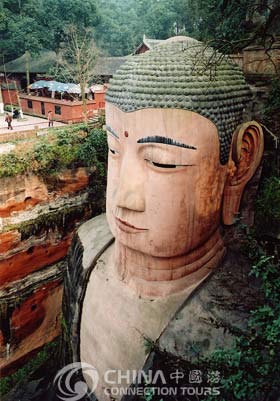 The Giant Buddha on the east bank of Minjiang Rive in Leshan City, Sichuan Province, rests his feet where three rivers the Minjiang, Qingyi and Dadu-join. The Buddha faces Emei Mountain across the river and at its back is the western slope of Lingyun Mountain. And it is reputed to be the largest carved stone Buddha in the world. A local saying explains, "The Mountain is a Buddha, the Buddha is a mountain". The Leshan Giant Buddha is currently being refurbished on a scale larger than that of any other renovation of the statue since it was carved in 713AD, during the Tang Dynasty (618-907) and was only completed in 803AD. The statue is not Sakyamuni, the founder of Buddhism, but his disciple Maitreya, also a Buddha.
The Giant Buddha on the east bank of Minjiang Rive in Leshan City, Sichuan Province, rests his feet where three rivers the Minjiang, Qingyi and Dadu-join. The Buddha faces Emei Mountain across the river and at its back is the western slope of Lingyun Mountain. And it is reputed to be the largest carved stone Buddha in the world. A local saying explains, "The Mountain is a Buddha, the Buddha is a mountain". The Leshan Giant Buddha is currently being refurbished on a scale larger than that of any other renovation of the statue since it was carved in 713AD, during the Tang Dynasty (618-907) and was only completed in 803AD. The statue is not Sakyamuni, the founder of Buddhism, but his disciple Maitreya, also a Buddha.
The Leshan Giant Buddha is as famous as the standing Buddhas of Bamiyan in Afghanistan and all of them are regarded as cultural heritages of mankind. With over 71 meters (230ft) tall with 28 meter (92ft) wide shoulders and a 15 meter (49ft) high head. More than 100 people can sit between the Buddha feet. Leshan Giant Buddha is an enormous statue carved into the cliff.
In the beginning, a 13-story wooden structure was built to house and protect the Buddha, but it was destroyed during the wars in the late Yuan Dynasty (1271-1368) and early Ming Dynasty (1368-1644). From then on, the Leshan Buddha has suffered from hundreds of years of erosion by atmospheric moisture and water infiltrating from the mountain. Water detained at the stomach of the Buddha has lowered the strength of the rock, and as a result, plants and fungi have sprung up from the upper part of the body. Because of acid rain, the Buddha's nose has turned black and the face has become speckled. What looks like tear stains can be found at the corner of the Buddha's eyes, and part of the body surface has begun to peel off. According to historical records, the past dynasties all did something to maintain the Leshan Buddha. In modern times, the Buddha has experienced six periods of large-scale maintenance, but all these projects failed to solve the problems for one reason or another.
The protection of the Leshan Buddha has drawn global attention. The United Nations Educational, Scientific, and Cultural Organization (UNESCO) have sent groups of experts to investigate and oversee the protection work. The World Bank has offered US$8 million in interest-free loans for the maintenance and protection of the Buddha, of which US$2 million has already been received. The protection of the Leshan Buddha is a project of ecological and scientific importance. The municipal government of Leshan has promulgated a series of measures to maintain the Buddha, including improving the macro-environment of the scenic area, harnessing the pollution sources, ordering industrial enterprises to move out of the scenic area within a specified time, controlling the pollution of the Minjiang River, and investing 200 million yuan this year to build a highway passing through the area. At present, the comprehensive treatment of the mountain, water, roads, and gardens in the area has been completed, and the environment has improved.

